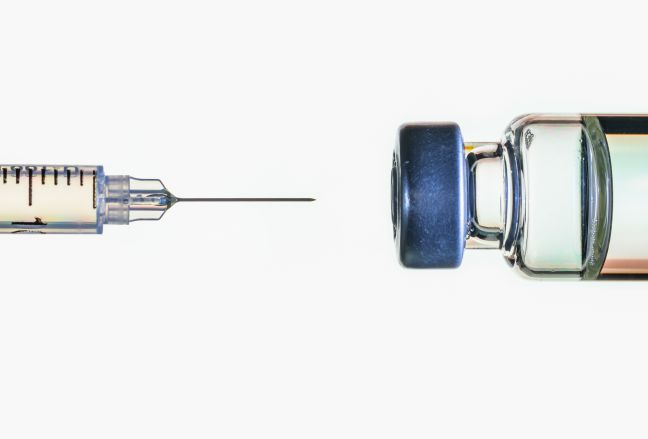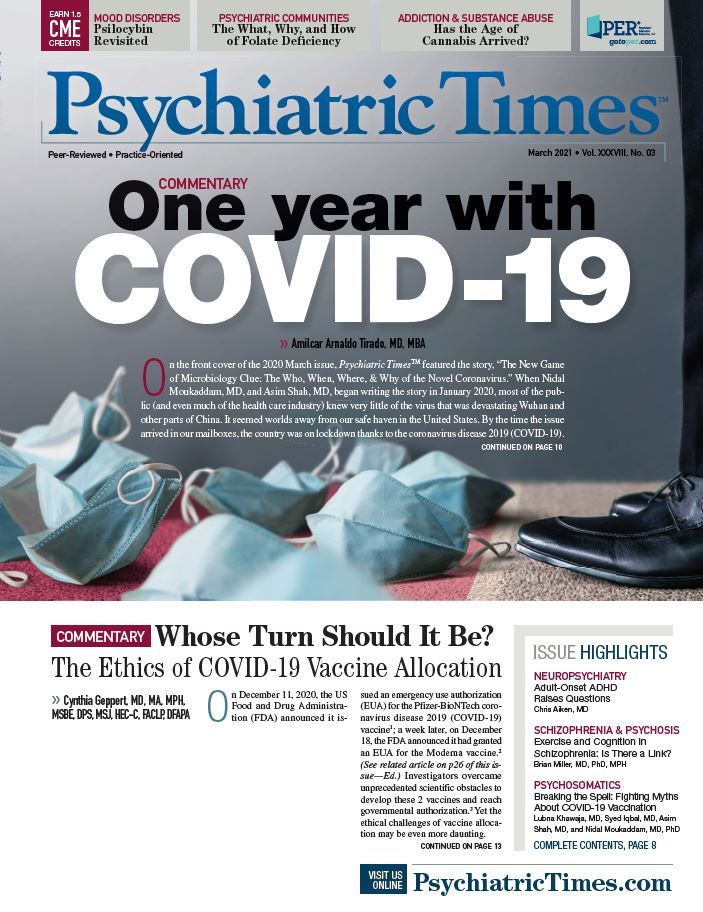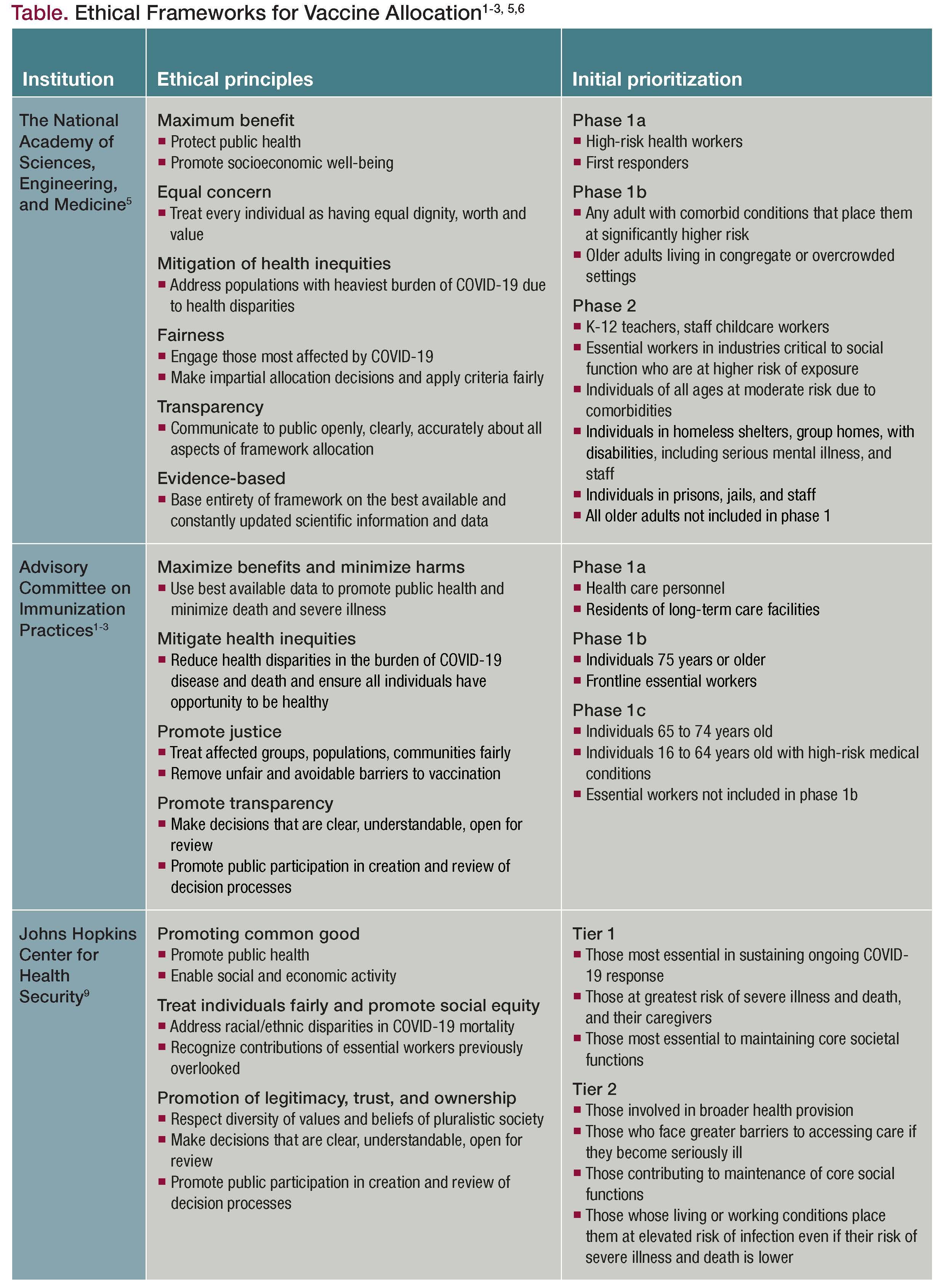Publication
Article
Psychiatric Times
Whose Turn Should It Be? The Ethics of COVID-19 Vaccine Allocation
Leaders are struggling to justly distribute the coveted vaccine, as their are many vexing ethical issues surrounding COVID-19.
phichak/AdobeStock

On December 11, 2020, the US Food and Drug Administration (FDA) announced it issued an emergency use authorization (EUA) for the Pfizer-BioNTech coronavirus disease 2019 (COVID-19) vaccine1; a week later, on December 18, the FDA announced it had granted an EUA for the Moderna vaccine.2 Investigators overcame unprecedented scientific obstacles to develop these 2 vaccines and reach governmental authorization.3 Yet the ethical challenges of vaccine allocation may be even more daunting.
Since at least 1962, when the FDA first grappled with the conundrum of who should get access to the novel dialysis machine,4 health care professionals, bioethicists, and public health leaders have wrestled with how to justly distribute the angel of life-saving resources when the devil is in the details precisely because the resource is scarce. Sadly, not everyone who needs and could benefit from life-saving care can receive it. Allocation decisions for COVID-19 vaccines are especially weighty, given that the virus has thwarted most other therapeutics, besieged the health care system, collapsed the economy, and caused widespread social disruption.
Resource Allocation
There are many vexing ethical issues surrounding COVID-19 vaccine allocation. Fortunately, we are not alone in navigating this moral labyrinth. In the past few months, several of the most respected public health institutions in the world have published reports that provide ethical frameworks for allocating the COVID-19 vaccine (Table1-3, 5,6). Any ethical framework must consider those with serious mental illness, and the hundreds of members of our specialty who are on the front line delivering COVID-19 care. (Note: future Psychiatric TimesTM articles will consider exactly where individuals with mental health illness should fall in the vaccine prioritization queue.)
Several observations about the ethics of COVID-19 vaccine allocation in the United States can be drawn from these summaries. First, the 3 American frameworks summarized in the Table contain principles of distributive and procedural justice.7 In the context of allocating scarce resources, “distributive justice” concerns the outcomes that are sought when competing ethical values, principles, and interests must be balanced. For example, ethical vaccine prioritization must balance utility in maximizing the reduction of severe disease and mortality from COVID-19, ensuring groups with health disparities have fair access to the vaccine and promoting respect for the dignity of vulnerable populations, such as those with disabilities.
“Procedural justice” concerns the process of specifying and weighing these many values, principles, and interests. For vaccine allocation planning and execution, an ethical process requires wide stakeholder input, transparent decision-making, and a clear mechanism for adjusting criteria in response to new scientific data and logistic developments.
The Table also illustrates the critical difference between the clinical ethics most of us practice, in which the preferences and needs of the individual patient are the locus of decision-making, and public health ethics, in which the common good is the focus.8 Another key distinction between the clinical and public health ethics is that legal, social, and even political factors wield much more powerful and pervasive influence in public health deliberations.9 The distinguishing pathophysiology and unique epidemiology of the COVID-19 crisis, stressing the nation at one of the most divisive times in US history, has revealed as never before the fault lines in American health care. The legacy of health disparities and structural racism have enabled the COVID-19 pandemic to savagely afflict communities of color.10 This made it morally incumbent upon the expert multidisciplinary panels who crafted these frameworks to incorporate not only traditional principles of utility and beneficence, but also the democratic values of equity and the dignity of all individuals.
The importance of remedying racial health inequities is one of the most difficult issues related to COVID-19 vaccine allocation. Some thought-leaders argue race should be directly addressed, as in prioritizing race as a health factor, while others recommend prioritizing the comorbidities that are more common among disadvantaged groups.11 Each of these and many other questions require ethical trade-offs, which are measured in human lives and economic disruption so long as there is not an adequate supply of vaccine and functional distribution plan and infrastructure.
Prioritization
As can be seen from the 3 primary American ethical frameworks for vaccine distribution, there is a general agreement that health care workers and other first responders on the front line of health care should also be among the first to receive the vaccine. There are multiple rationales to support the primacy of health care workers: they are among the populations at highest risk for exposure; they are a scarce resource, without which the health care system collapses, leading to more disease and death; and they are owed reciprocity for putting their professional obligation to care for the sick above their personal interests. The critical role of health care workers has led some in the public health field to contend that vaccination should be mandatory for employment. Although it has gained legal traction, this proposition violates the ethos of liberty and autonomy that has been the hallmark of American professionalism.12
Similarly, all but the most utilitarian among us will support vaccinating older, sicker Americans before younger ones, especially those in congregate living situations, along with the staff who care for these vulnerable patients. Data have consistently shown a higher risk of morbidity and mortality from COVID-19 with age and comorbidities such as diabetes and hypertension.12 Individuals in nursing homes, group homes, and residential programs, many of whom are patients with mental health disorders, often have overlapping comorbidities that reduce their ability to protect themselves from infection.13 Similarly, there is an over-representation of ethnic and social groups with greater health disparities in lower-paying caregiver jobs.14 That being said, there is an alternative position arguing that it is those in the prime of life who should preferentially receive scarce resources, as their investment in society has not yet been returned, and they have the best chance of recovery when stricken with the virus.15 From these perspectives the thrust of our efforts should be on vaccinating younger cohorts in whom vaccination is likely to be more effective in reducing transmission.16
A Fragile Consensus
For ethical guidance to be flexible enough to respond to the rapidly evolving scientific knowledge and dynamic nature of conditions on the ground, it cannot be overly prescriptive or rigid. This leaves latitude for interpretation, especially among the states where the actual implementation occurs and, hence, room for disagreement, especially as we move down the levels of the framework. A clear example of this phenomenon was when the federal government encouraged states to begin vaccinating all those 65 years and older. But when the nationwide immunization effort lagged the schedule, the Department of Health & Human Services modified prior US Centers for Disease Control and Prevention guidance, ruling that 75 years of age should be the cutoff for 1b vaccine prioritization.17
Among the most problematic questions is “Who is an essential worker?” For a single mother, it is essential that her school-age child’s teacher be vaccinated so schools can open, so the mom can return to work. On the other hand, mass transit and social services workers may be necessary for survival for an urban family whose breadwinner has lost their job due to the pandemic. Even reasoned efforts to choose the most crucial groups raise the specter of social worth criteria, by which some individuals are deemed more valuable than others.
The Neglected Cohort
A careful review of these frameworks suggests that they overlook patients with mental illness and mental health care professionals. Patients with mental illness and those who care for them are often sidelined during major health care initiatives; that other struggle for parity and equity extends to vaccine allocation in this pandemic.
Mental health has been discounted in a range of health care scenarios, from representation on the expert panels that produced the reports to inclusion of psychiatrists in essential health care worker categories to specific attention to the needs and challenges of vaccinating patients with mental illness. An ethical analysis of how our profession and patients should fit into vaccine allocation frameworks, and practical recommendations for promoting immunity in our community, remain to be done.
Dr Geppert is professor, Department of Psychiatry and Internal Medicine, and director of Ethics Education, University of New Mexico School of Medicine in Albuquerque, New Mexico; she is also health care ethicist, Ethics Consultation Service, VA National Center for Ethics in Health Care and adjunct professor of bioethics, Alden March Bioethics Institute Albany Medical College.
References
1. United States Food and Drug Administration. FDA takes key action in fight against COVID-19 by issuing emergency use authorization for first COVID-19 vaccine. Press release December 11, 2020. Accessed January 26, 2021. https://www.fda.gov/news-events/press-announcements/fda-takes-key-action-fight-against-covid-19-issuing-emergency-use-authorization-first-covid-19
2. United States Food and Drug Administration. FDA takes additional action in fight against COVID-19 by issuing emergency use authorization for second COVID-19 vaccine. Press release December 18, 2020. Accessed January 26, 2021.
https://www.fda.gov/news-events/press-announcements/fda-takes-additional-action-fight-against-covid-19-issuing-emergency-use-authorization-second-covid
3. Hennessy M. How pharmaceutical innovation is saving the world. Psychiatric TimesTM. 2021;38(2):1,3. https://www.psychiatrictimes.com/view/how-pharmaceutical-innovation-saving-world
4. Pence GE. Medical Ethics: Accounts of Ground-Breaking Cases, 8th edition. McGraw Hill; 2016.
5. Foege, WH, Gayle, HD, Brandeau, ML, ed. Framework For Equitable Allocation of COVID-19 Vaccine. National Academies of Sciences, Engineering, and Medicine. October 2, 2020. Accessed January 26, 2021. https://www.nap.edu/read/25917/chapter/1
6. Toner E, Barnill A, Krubiner C. Interim Framework for COVID-19 Vaccine Allocation and Distribution in the United States. Johns Hopkins Center for Health Security; 2020.
7. Foglia MB, Pearlman RA, Bottrell MM, Altemose JA, Fox E. Priority setting and the ethics of resource allocation within VA healthcare facilities: results of a survey. Organ Ethic. 2008;4(2):83-96.
8. Leeder SR. Ethics and public health. Intern Med J. 2004;34(7):435-439.
9. Jennings B. A strategy for discussing ethical issues in public health. In: Jennings B, Kahn JP, Mastroianni A, Parker LS, eds. Ethics and Public Health: Model Curriculum. Association of Schools of Public Health;2003:1-12.
10. Lee IJ, Ahmed NU. The devastating cost of racial and ethnic health inequity in the COVID-19 pandemic. J Natl Med Assoc. 2020:S0027-9684(20)30434-X.
11. Schmidt H, Gostin LO, Williams MA. Is it lawful and ethical to prioritize racial minorities for COVID-19 vaccines? JAMA. 2020;324(20):2023-2024.
12. Vestal C. Health care workers can decline a COVID-19 shot—for now. Stateline. December 8, 2020. Accessed January 26, 2021. https://www.pewtrusts.org/en/research-and-analysis/blogs/stateline/2020/12/08/health-care-workers-can-decline-a-covid-19-shot-for-now
13. Imam Z, Odish F, Gill I, et al. Older age and comorbidity are independent mortality predictors in a large cohort of 1305 COVID-19 patients in Michigan, United States. J Intern Med. 2020;288(4):469-476.
14. Bagchi S, Mak J, Li Q, et al. Rates of COVID-19 among residents and staff members in nursing homes - United States, May 25-November 22, 2020. MMWR Morb Mortal Wkly Rep. 2021;70(2):52-55.
15. Emanuel EJ, Persad G, Upshur R, et al. Fair allocation of scarce medical resources in the time of Covid-19. N Engl J Med. 2020;382(21):2049-2055.
16. Matrajt L, Eaton J, Leung T, Brown R. Vaccine optimization for COVID-19, who to vaccinate first? medRxiv. Preprint. Published online August 15, 2020:2020.08.14.20175257. https://pubmed.ncbi.nlm.nih.gov/32817963/
17. Simmons-Duffin, S. Trump Administration Urges States to Open COVID-19 Vaccination to Everyone over 65. National Public Radio. January 12, 2021. https://www.npr.org/sections/health-shots/2021/01/12/956017635/trump-administration-to-change-covid-19-vaccination-guidance-to-speed-up-rollout ❒







